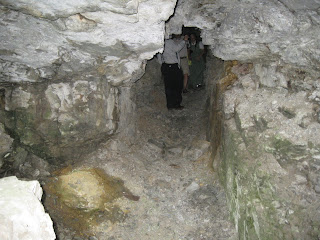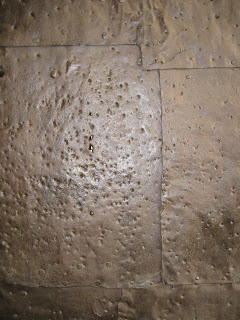Today was a holiday here in Sued Tirol, Mary’s Ascension
Day, so while everybody else was observing that, we had Hutter Day. No, I
didn’t just invent a holiday, but that’s what it felt like with all the Hutter
related places we toured today.
One of the places we saw today was the Bishof Residenz.
It’s a big palace, (you see only part of it here) but we were not able to go inside. Quite a contrast, knowing
how the peasants were treated compared to how the Bishop at the time lived,
which ultimately led to the Peasant's Revolt.
This gate just outside this grand Palace
is where the peasants banged and hammered, wanting to be heard. As you can see the marks are still there, helping to tell this story. It's assumed that Jakob Hutter
was a part of this, and is where he learned that using
violence to emphasize a point is never a good idea, as it doesn't accomplish anything.
We visited the place where Jakob Hutter was born. The house is not
there anymore, as it burned down some years ago and another has been built in
its place. But close to where it was, there’s a plaque on a stone to
commemorate this birthplace. It’s privately owned property, so we just took some
pictures and left. The people living there are kind enough to allow these
Hutterite visits from time to time. I’m so grateful to the people who put up
these plaques!
This house in Klausen is where Jakob and Katharina
Hutter were captured. The people living in the home sympathized with the
Anabaptists and assisted them sometimes, knowing it could cost them their
lives.
They were taken to Schloss Branzoll, (in the background) where they stayed only a few days.
In all the castles we've seen, there are MANY with stairs like these, leading to the top. Not an easy climb, but so worthwhile, not only for the view from there, but also to stay there for a while and reflect on the stories.
Jakob was taken to Innsbruck and Katharina to
Schloss Summersberg in Guffidaun. She was pregnant at the time and when her baby
was born, they took it from her and placed it in a Catholic home, ‘so that it
doesn’t end up in hell’. The baby was never heard of again. Nobody even knows
whether it was a boy or girl. Horrible enough to be separated from her husband
and not knowing what will become of both her and him, they had to take her
baby as well. Sometime later, someone helped Katharina escape. Two years later
though, she was recaptured, kept at Schloss Schoeneck where she was drowned in
a water trough. As I said in an earlier post, Jakob Hutter was burned at the
stake in Innsbruck.
Robert Hochgruberm our tour guide
These caves are also in Guffidaun. That’s where the first
Anabaptists met for worship or hid from their enemies. Really gave me something
to think about, while we’re free to worship in big comfortable churches, our
forefathers gathered in caves.

Hutter’s legacy lives on. He had brought strong leadership to Anabaptists that had been fragmented into at least a dozen different groups. During his years as chief elder of the group, he had forged working communal groups, creating practical regulations and organizational structures for making communal life work. As a result, these groups, gained the structure they needed to live their life for Christ in community. (Hutterian Brethren Website)








No comments:
Post a Comment
Thanks for stopping by my blog and for sharing your thoughts!!